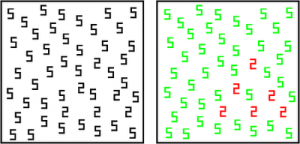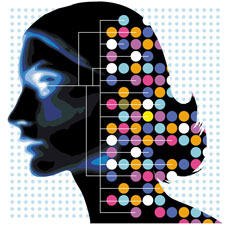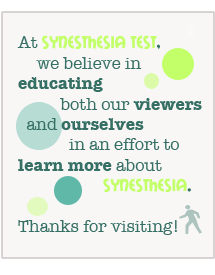Synesthesia Test Variations
Synesthesia is a condition of the mind in which our brain’s processing of the senses is intertwined. While some who experience the condition may consider it a nuisance (at times), those on the outside (looking in) often regard the condition as nothing less than phenomenal. People who experience synesthesia are nominally labeled as synesthetes. Synesthetes experience the world around us in a different way. Have you ever tasted the richness of the color blue, or seen the brilliant orange streaks of a high C note? Do you perceive sensations with a sense that doesn’t seem to belong? Probably not. If you have had a similar experience, though, there’s a good chance that you’re the one synesthete in every 2000 people. Still curious? Good! There are a variety of synesthesia tests that can help you verify or nullify your personal relationship with the condition.
Visual Tests
A common test for grapheme-color synesthesia is having the subject in question look at a picture with several black letters or numbers. A person without synesthesia will look at this picture and see it as it is: a picture with black letter and numbers. He or she will not see anything atypical. However, a synesthete (who associates specific colors with specific letters and/or numbers) may look at the same picture and perceive something quite different. As he or she begins to scan through the letters and numbers, each has its own respective color – a bijection of sorts between grapheme and color. While this is a rather simple synesthesia test, it does its job, providing quick, most-often definitive results.

The above picture depicts an example of how a synesthete experiencing grapheme-color synesthesia might perceive the numbers (right) compared to normal perception (left). The test, in this case, is how fast the subject is able to find all of the number 2s in the picture. While a person with normal perception tends to have trouble hastily distinguishing between the 5s and the 2s, a grapheme-color synesthete may perceive 5s as one color and 2s as another, making the task a much easier one. You get the idea. Simple, yet effective.
Auditory Tests
Since there are numerous types of synesthesia, a visual test is not the only kind of synesthesia test you will find on the internet. For example, there also exists auditory synesthesia, which occurs when a sound activates an additional sense (to hearing) for a synesthete. To be able to test for auditory synesthesia, one will be asked to listen to a collection of sounds to see if he or she experiences a sensory perception that is not mundane (e.g. seeing colorful shapes or tasting a certain flavor).

Test-Retest
This is a type of test where a person is given a set of objects (e.g. numbers) and is asked to assign colors, tastes, personalities, or more. After a certain amount of time, they are given the same objects again and asked to do the same task. A synesthete will be able to assign the same characteristics very easily, as they’ve already made neural associations which are automatic and consistent.
Stroop Effect
Also known as the Stroop test, this pertains to a kind of psychology test that researchers use to demonstrate the subject’s reaction time for a task. It is widely used in clinical practice. Because Stroop tests are used to measure reaction time (and due to the fact that synesthesia is automatically evoked), researchers use them to see if the reactions within a person’s brain are consistent with those standard in a brain altered by synesthesia.




